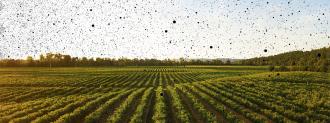By spreading rock dust over large areas of farmland, we could cause the soil to absorb considerably more carbon from the air, while improving crop yields — a double win for farmers and the environment.
According to a paper published in the journal Nature, if farmers in China, the United States, and India all gave enhanced mineral weathering a try, we could remove one billion metric tons of carbon dioxide from the atmosphere per year.
What is enhanced weathering? The idea is simple — accelerate farmland’s naturally occurring chemical reactions by adding minerals in the form of crushed rocks. The chemical processes that break down the stones simultaneously trap atmospheric carbon.
As part of Earth’s natural carbon cycle, rainwater dissolves carbonate minerals in the crushed rock, forming a solution. Then carbon dioxide in the air dissolves in the solution, generating bicarbonate ions. Eventually, these ions form carbonate crystals that can lock in carbon for millennia, reports the Washington Post.
This could be an effective way to make farmland a carbon sponge.
“This is an incredibly exciting technology that has a lot of wins for society and, frankly, we could deploy this very quickly.”
Ben Houlton
Natural rock weathering already removes more than a gigaton (one billion tons) of CO2 from the atmosphere each year. Scientists believe we could tap into this process and remove even more — potentially, a lot more.
The big picture: Scientists generally agree that to reach the goal outlined in the Paris Agreement of limiting global temperature rise below 2 degrees Celsius, we need to do more than reduce new carbon emissions. We also need to suck vast amounts of CO2 from the atmosphere and lock it away forever.
Various ideas have been proposed for this — from direct air capture with huge machines to genetically modifying trees to sequester more carbon to huge fleets of kelp platforms in the ocean.
But compared to the more wild ideas, enhanced mineral weathering appears to be pretty straightforward.
The technique would work if rock dust were applied to just about any large area of land, but it is especially effective on farmland because farmers already enrich crops with minerals. They often use broken lime to minimize soil acidity, so they are already prepared with the equipment and know-how to disperse rock dust.
Adding other rocks could enhance soil fertility and crop yields, so it’s possible that the application may quickly become normal and desired, reports The Guardian.
“CO2 drawdown strategies that can scale up and are compatible with existing land uses are urgently required to combat climate change, alongside deep emissions cuts,” said the University of Sheffield’s David Beerling, a lead author of the Nature study. “[Enhanced rock weathering] is a straightforward, practical approach.”
The study found that China, India, and the U.S. — the three largest emitters of CO2 in the world — as well as Brazil, could collectively remove up to two billion tons of CO2 per year by pursuing enhanced weathering on existing farmland.
The study estimated that the costs were not trivial (between $80 and $180 per ton of CO2 removed) but similar to or lower than other carbon-capture technologies. And that didn’t count the ancillary benefits, like reducing ocean acidification and improved soil quality.
In the field: Agriculture accounts for a significant share of global greenhouse gas emissions — about one-fourth of the total — making it a critical component in achieving net-zero emissions. But farming emissions, like those from fertilizer and cattle burps, are even harder to avoid than those from electricity, where you could substitute nuclear or solar for coal and gas.
Adding rock weathering to the mix could offset a lot of farming emissions that can’t be otherwise avoided.
In a second mineral weathering study, a team of researchers at the Working Lands Innovation Center, a research consortium at UC Davis, has been field-testing the technique for the past two years. They are comparing rock dust and other soil additives to see how well they soak carbon from the atmosphere and store it underground.
”As far as I can tell,” Ben Houlton, lead researcher with the consortium, told Yale Environment 360, “ours is the largest-scale project of its kind, using this intensive sort of scientific approach.”
Houlton and the other researchers are studying how varying amounts of rock dust impact hemp fields near Geneva, New York. They are among a group of researchers who are testing different rocks for their carbon-soaking abilities, as well as researching their abundance, cost, and safety in the soil. (For example, wollastonite rock is good at sequestering carbon, but it isn’t common enough to be used on a wide scale.)
“This is an incredibly exciting technology that has a lot of wins for society and, frankly, we could deploy this very quickly,” says Houlton.
The field trials take a lot of time, and researchers need many trials to understand the benefits and issues with each crop-mineral combination, and with different climates. Initial data from California plots suggest that carbon uptake doubled, despite being in the state’s driest conditions on record.
What’s next? Houlton and Beerling both plan to continue their ongoing studies and expect to publish more results as early as next year.
Beerling is five years into his study, with plans for an additional five years. He told Yale Environment 360, for example, that applying rock dust to fields for mineral weathering may mean that farmers can use less nitrogen fertilizer. This could reduce nutrient pollution, which would especially benefit areas where runoff drains into the Mississippi watershed.
In the future, it may also be possible for farmers to earn money by sequestering carbon. Earlier this year, the Biden administration suggested that farmers should be paid for growing carbon-sequestering crops. If a carbon market were to crop up, enhanced mineral weathering could be the key to “carbon farming.”
We’d love to hear from you! If you have a comment about this article or if you have a tip for a future Freethink story, please email us at [email protected].






